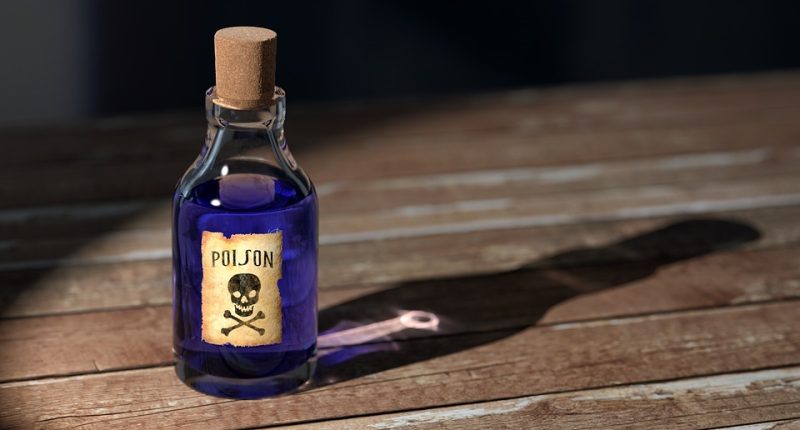- LOCAL: the local action of poison by coming in direct contact with the part
- Chemical destruction by corrosives
- Congestion and inflammation by irritants
- Effects on motor and sensory nerves e.g. tingling of skin and tongue by aconite, dilation of pupils by belladonna or dhatura.
- REMOTE: remote action produced either by shock acting reflexly through severe pain caused by corrosives, or by poison being first absorbed into the system through the blood, and then exerting a selected action on certain organs and tissues e.g. cantharides action on kidneys produces nephritis, nux vomica working on the spiral cord causes convulsions.
- COMBINED: drugs like phenol or carbolic acid, oxalic acid, etc causes local and remote actions.
Factors Modifying the Action of Poisons
- Quantity/dose: More the number, more severe are going to be the toxic effects. A large quantity of poison taken orally may cause vomiting, causing its rapid elimination and decreased toxicity e.g. alcohol, copper sulphate etc. The action of poison varies with the dose. A resultant effect could also be different with the larger dose as compared to the smaller one. Therefore, the cause of death with the larger dose could also be shock, whereas with a smaller dose over a longer period, the cause of death may be different.
- Form
• Physical form: Gases and vapors act sooner than liquid. Liquid poisons act sooner than solid ones, of which fine powders act more quickly than coarse ones. Some poisonous vegetable seeds may undergo through the GIT as such when taken intact due to their impermeable pericarp. But when taken crushed, they’ll be rapidly fatal.
• Chemical combination: Action of poison depends upon the solubility or insolubility with certain solutions or reagents resulting from chemical combination, e.g. AgNO3 and HCl are both strong poisons, but when combined, form an insoluble salt of AgCl which is harmless. A substance could also be harmless in metallic state but its salts may be toxic, e.g. arsenic isn’t poisonous but its salts could also be poisonous. Certain poisons which aren’t soluble in water may become dissolved within the acid secretion of the stomach and absorbed into the blood, e.g. lead carbonate and copper arsenite.
• Mechanical combination: Action of poison is altered when combined with other substances. Corrosives when sufficiently diluted act as irritants.
3. Mode of administration: In order of rapidity of action: Inhaled in gaseous/vaporous form > injection (IV) > Intramuscular (IM), subcutaneous and injection > Application to a wound > Application to serous surface > Ingestion > Introduction into the natural orifices > Application to unbroken skin. ‘>’ this sign indicates more rapidly acting) if the active dose orally is taken into account together as one unit, the rectal dose about 1½-2 times and therefore the hypodermic dose is about ¼.
4. Cumulative Action of the Poison: Preparations of cumulative poisons (poisons that aren’t readily excreted from the body and have a tendency to pile-up in several organs of the body for an exenteded period) might not cause any toxic effect when entering in low doses. However, when such poisons enter the body over an extended period even in low doses, may ultimately cause harm when their concentration in several tissues reaches high level due to their cumulative effect.
5. Drug Interactions: Drug interactions are known to occur due to changing of 1 drug or increasing the response to a different drug or food material. A patient on treatment with a MAO inhibitor may suffer severe respiratory depression to ordinary doses of pethidine. Drugs such as sedatives, hypnotics, tranquilisers, antihistamines can significantly increase the effect of alcohol. Evaluation of the hazards from exposure to multiple chemicals are often far more demanding than is that the case for a one chemical.
6. Condition of the patient
- Age: Age has considerable effects upon the dosages of drugs or medicine. Poisons have greater effect at the 2 extremes of aged. A child or toddler doesn’t have fully developed drug metabolizing enzymes and effective barrier and as such more vulnerable to the effect of most drugs.
- State of health: A healthy person tolerates poisons better than an inndividual with diseased. General debility, senility, chronic or disabling disease may cause death of an individual to a dose that’s ordinarily safe, e.g. opium in asthma or mercury in chronic nephritis. In some diseases large doses of certain drugs could also be given without harmful effects, e.g. Opium in tetanus and strychnine in paralysis.
- Sleep and intoxication: Action of poison is delayed, if an individual goes to sleep soon after taking it. Action is additionally delayed, if one takes a poison in an intoxicated state.
- Tolerance and idiosyncrasy: it may be defined because the inherent personal hypersensitivity to the agent in question. The symptoms usually occur within the skin but could also be of a more general nature with dyspnoea. Sometimes, a little or otherwise innocuous dose of a substance may end in severe toxicity. This phenomenon could also be explained as an abnormal response of the body and is usually an allergic response to the substance.
- State of stomach: Presence of food stuff within the stomach acts as diluent of the poison and hence protects the stomach wall from the corrosive and irritating action of the poison. Dilution of poison also delays the absorption. Some specific sort of food has specific action on absorption of the poison. Fatty food usually delays the process. However, presence of fatty food may accelerate the method of absorption just in case of phosphorus.
- Absorption is typically rapid where the stomach is empty. Conversely, a substance could also be destroyed within the elimentary canal and should not manifest toxicity, e.g. d-tubocurarine or venom.
- Cumulative action: Poisons which aren’t excreted or removed tends to accumulate within the body when given in repeated doses and produce symptoms when their concentration reaches the edge.
- Routes of elimination: The absorbed one poison is mainly excreted through the kidneys or also through the skin. Other routes are also present such as bile, milk, and saliva, mucous and serous secretions. Unabsorbed one is excreted in the vomit and feces.
- Conditions surrounding the victim: Activity, crowding, presence of people and then on may have an impact on the response to a poison. Certain poisons are influenced by the temperature or the humidity prevailing within the atmosphere. Such as, atropine has a much greater adverse effect during a desert situation than during a cool, moist climate.
For more updates, subscribe to our blog.







